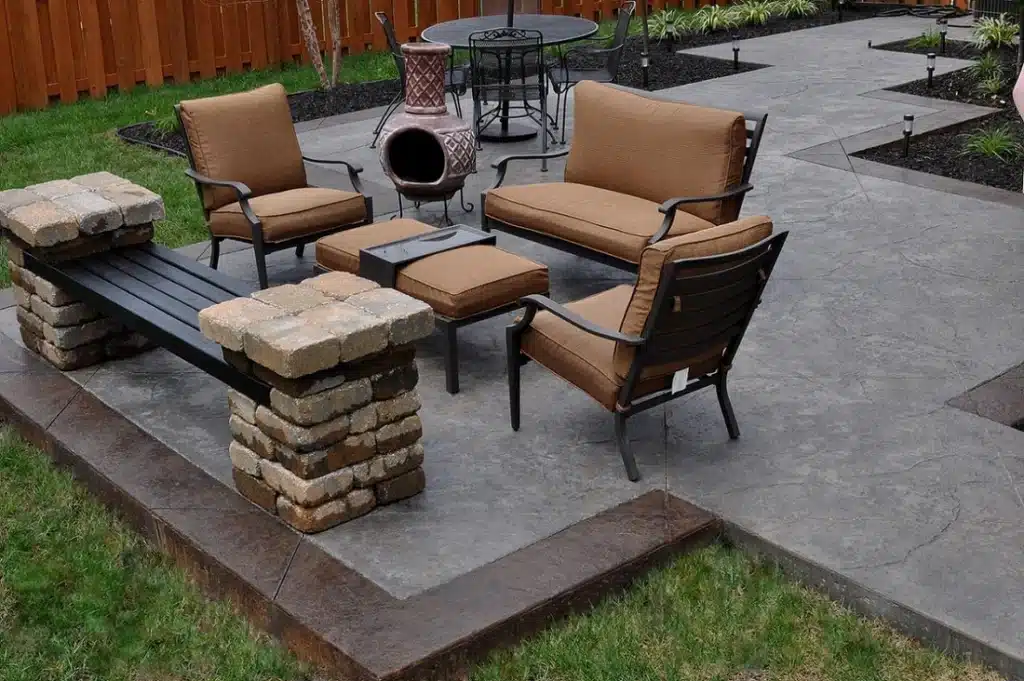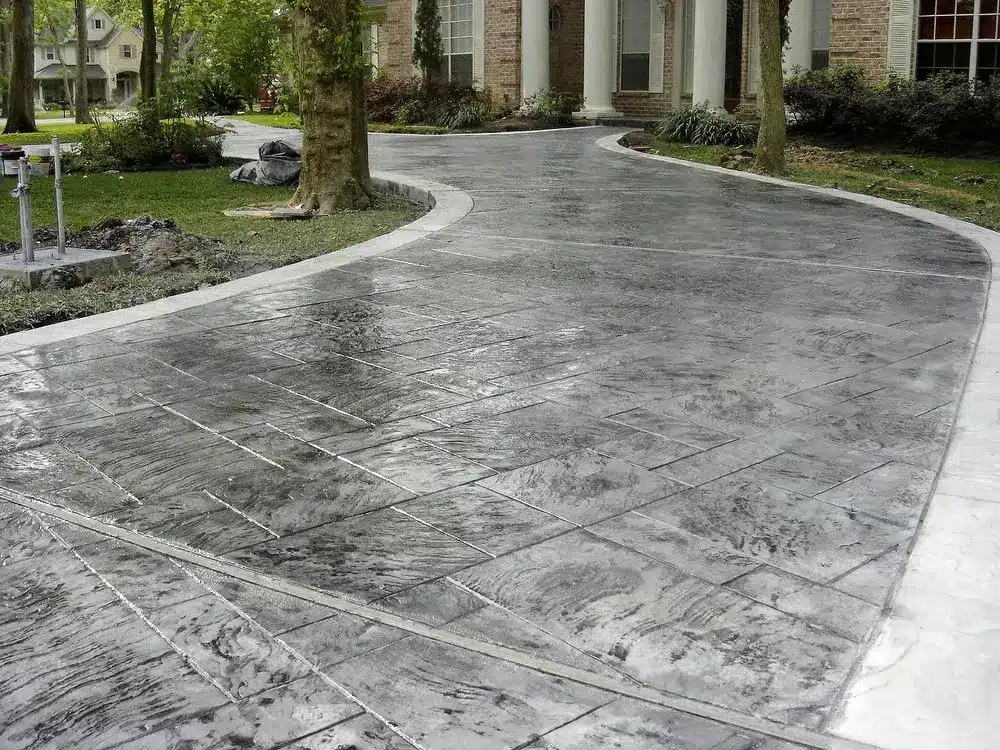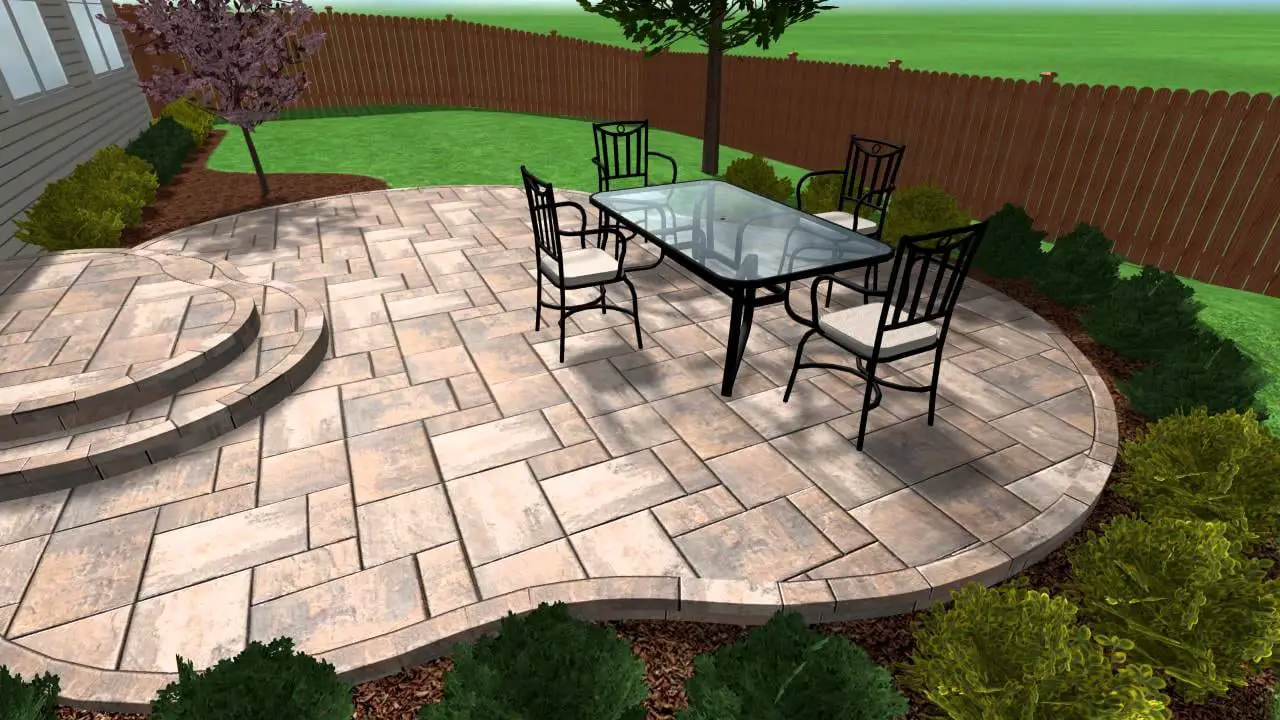How To Do Stamped Concrete Patio
Introduction
How To Do Stamped Concrete Patio: Stamped concrete patio is a popular choice for homeowners who want to enhance the look and functionality of their outdoor living space. This type of patio is created by pouring concrete and then using stamps to create a pattern or texture on the surface. The result is a beautiful and durable patio that resembles more expensive materials such as brick or stone.
Creating a stamped concrete patio may seem like a daunting task, but with the right tools and techniques, it can be a relatively simple and rewarding project. The first step is to prepare the area where the fix patio will be located. This involves clearing away any vegetation, leveling the ground, and installing a base of gravel or sand to ensure proper drainage.
Once the area is prepared, the next step is to pour the concrete. This can be done using a concrete mixer or by hand, depending on the size of the patio. It is important to mix the concrete thoroughly and pour it evenly to ensure a smooth and level surface. After the concrete is poured, the next step is to use stamps to create the desired pattern or texture. Stamps are available in a variety of designs, including brick, stone, and tile. They are pressed into the wet concrete to create the desired effect. It is important to work quickly and efficiently to ensure that the stamps are applied evenly and that the concrete does not dry before the stamping process is complete.

How is a stamped concrete patio done?
Concrete is poured into a pattern-printed mold to build this patio. After drying, the concrete is stamped with various tools to achieve the desired look and structure.
Getting the area suitable for a stamped concrete patio is the first step.
After setting up the form, the concrete can be put into the right spot. It is necessary to make sure that the concrete is put level and thick enough. A trowel or float is used to smooth and level the concrete after it has been poured. For the pressing process, this helps make the surface flat and even.
While the concrete is still dry enough to hold a person, the pounding process can begin. Stamps are usually made of polyurethane or rubber, and they come in many shapes and colors. To get the pattern and design you want, the stamps are pressed into the concrete by applying pressure and twisting the concrete.
Once the whole patio has been stamped, the concrete needs to be left to fully dry. This usually takes a few days, but it depends on the weather. After the concrete has hardened, a sealer can be used to cover the surface and make the patio look better.
How to do stamped concrete step by step?
Stamped concrete is a popular choice for homeowners who want to enhance the appearance of their outdoor spaces. This decorative concrete technique involves imprinting patterns and textures onto freshly poured concrete to mimic the look of more expensive materials like stone, brick, or tile. If you’re interested in learning how to do stamped concrete step by step, this guide will walk you through the process.
Mixing and Pouring the Concrete
After getting the area ready, the concrete needs to be mixed and poured. To get the right water-to-mix ratio, read and follow the directions on the bag of concrete mix. To mix the concrete well, you can use a concrete mixer or a bucket and shovel. Make sure the concrete is spread out properly as you pour it into the ready area. Level the ground and get rid of any extra concrete with a sand board.
Adding Color and Texture
Color and pattern can be added after the concrete has been poured and evened out. To get the look you want, you can use essential color, dry shake color hardeners, or concrete stains, among other things. Pick the way that works best for your design and then follow the maker’s hints. After the color is on, you can use stamping mats or texturing skins to make the image you want on the concrete. Systematically work to make sure that everything looks the same.
Is stamped concrete a good idea?
It looks like expensive materials like brick, stone, and tile because it has designs and textures that look like them. But there are a few things you should think about before you choose stamped concrete for your job.
Stamped concrete is very useful because it can be used in many ways. You can match your concrete to your style and the look of your home because there are many designs and colors to choose from. You can add a natural cobblestone pattern or a sleek modern tile pattern to stamped concrete to make it your own.
Stamped concrete looks good and lasts a long time. If it is built and kept correctly, concrete can stand up to heavy foot traffic, harsh weather, and regular use without cracking or fading. It’s great for roads, patios, pool decks, and other outdoor areas that get a lot of use because of this.
Stamped concrete is also a good choice because it is affordable. In terms of price, stamped concrete is less expensive than raw stone or brick. Overall costs are lower because the building process is usually faster and requires less work. Stamped concrete also doesn’t need much upkeep, which saves you time and money in the long run.
What is the best mix for stamped concrete?
If you use the right mix, stamped concrete can last, look good, and last.
The amount of cement to aggregate is also important. Concrete that has more cement in it is stronger and lasts longer, but it may crack more easily. More gravel may make concrete easier to work with and less likely to crack, but it may also make it less strong. The right amount of cement to pebbles is needed for the best stamped concrete mix.
Additives make pressed concrete look better and work better. Some of these are colorants, plasticizers, and speed up agents. It hardens faster with accelerators, and it’s easier to work with and needs less water with plasticizers. Anything can be colored to look like brick or stone. What materials and amounts are used depend on the needs and goals of the job.

What materials do I need to stamp concrete?
If you want to add designs and textures to concrete, one popular way is to stamp it. It is often used to improve the look of roads, patios, and paths. You will need a few simple tools that are made just for stamping concrete in order to do it right.
Another important thing you need to stamp concrete is a stamping mat or skin. These are the things you use to shape and smooth out the concrete. Most stamping mats are made of polyurethane that is bendable and come in different forms, such as brick, stone, and tile. On the other hand, thick stamping skins are used to add designs like cobblestone or wood grain.
You will also need color hardeners or vital colorants. These are used to add color to the concrete, which makes it look brighter and more real. Color hardeners are put on top of the concrete before it is pressed, and integral colorants are mixed right into the concrete. With either choice, you can pick from a lot of colors.
To make a stamped concrete patio, you’ll need a few things. The first and most important thing is concrete. It’s very important to use concrete that is thick and made to be stamped. It’s generally made of cement, sand, and aggregate, and the way it’s mixed makes it firm enough to print on. You can also change the color of the patio by adding color hardeners or essential color to the mix.
What materials are needed to create a stamped concrete patio?
To create a stamped concrete patio, you will need several materials. The first and most important material is concrete. You will need enough concrete to cover the entire area of your patio. It is recommended to use a high-quality concrete mix that is specifically designed for stamping. This type of concrete mix contains additives that make it more workable and easier to stamp.
In addition to concrete, you will also need release agents. Release agents are applied to the surface of the concrete before stamping to prevent the stamps from sticking. They also add color and texture to the finished patio. There are various types of release agents available, including powder and liquid forms. It is important to choose a release agent that complements the desired color and texture of your patio.
How can different patterns and designs be achieved with stamped concrete?
Creating different patterns and designs with stamped concrete is one of the main advantages of this type of patio. There are several techniques and tools that can be used to achieve various patterns and designs. One common method is the use of stamping mats or skins, which are textured mats that are pressed onto the wet concrete to create a specific pattern. These mats come in a wide variety of designs, such as brick, stone, tile, and even wood, allowing homeowners to mimic the look of more expensive materials at a fraction of the cost.
Another technique that can be used to achieve different patterns is the use of concrete stains or dyes. These products can be applied to the surface of the concrete after it has been stamped to add color and depth to the design. Stains and dyes come in a wide range of colors, allowing homeowners to customize their patio to match their personal style and preferences. Additionally, different application techniques, such as spraying or brushing, can be used to create unique effects and patterns.
Are there any special tools or equipment required for stamping concrete?
Yes, you do need a few special tools and pieces of equipment to stamp concrete and make the designs and shapes you want. The concrete stamp is one of the most important tools because it makes the surface of the concrete look rough and interesting. Rubber or polyurethane are some of the materials that concrete stamps are made of. They also come in different shapes and sizes. Usually, these stamps are put on wet concrete and pressed down to make the image that is wanted.
Along with concrete stamps, a concrete mixer, a trowel or float to smooth the surface, a release agent to keep the stamps from sticking to the concrete, and a sealer to protect the surface are all standard tools and equipment used for stamping concrete. It’s also helpful to have water on hand to clean the stamps and tools before and after printing.
Overall, it’s important to have the right tools and equipment when stamping concrete to get the shapes and designs you want. These tools not only help make the surface look good, but they also make sure that the stamped concrete patio will last for a long time.
What is the recommended maintenance for a stamped concrete patio to ensure its longevity?
Maintaining a stamped concrete patio is essential to ensure its longevity and keep it looking its best. Regular maintenance can help prevent damage and extend the lifespan of the patio. Here are some recommended maintenance tips:
1. Cleaning: Regularly clean the stamped concrete patio to remove dirt, debris, and stains. Use a mild detergent and water to scrub the surface with a soft-bristle brush. Avoid using harsh chemicals or abrasive cleaners, as they can damage the sealant and the concrete itself.
2. Sealing: Apply a high-quality concrete sealer every 2-3 years to protect the surface from moisture, UV rays, and stains. The sealer will help maintain the color and integrity of the stamped concrete, as well as make it easier to clean and maintain.
3. Avoiding heavy objects: Avoid placing heavy objects or furniture directly on the stamped concrete patio, as they can cause cracks or indentations. Use furniture pads or coasters to distribute the weight and protect the surface.

Conclusion
Stamped concrete patios are a popular choice for homeowners looking to enhance their outdoor living space. This versatile and durable material offers a wide range of design options, allowing you to create a patio that perfectly complements your home and personal style. Whether you’re a seasoned DIYer or new to home improvement projects, learning how to do a stamped concrete patio can be a rewarding and cost-effective way to upgrade your outdoor space.
Before you begin the process of installing a stamped concrete patio, it’s important to gather all the necessary materials and tools. This includes concrete mix, stamps, colorants, release agents, and various hand tools. It’s also crucial to carefully plan and measure the area where you want to install the patio, ensuring that it will fit seamlessly into your existing landscape.
Once you have all the materials and tools ready, the first step in the process is to prepare the site. This involves clearing the area of any vegetation or debris, leveling the ground, and creating a solid base for the concrete. It’s important to take your time with this step, as a properly prepared site will ensure the longevity and stability of your stamped concrete patio.
After the site is prepared, the next step is to mix and pour the concrete. This can be done using a concrete mixer or by hand, depending on the size of your project. It’s important to follow the manufacturer’s instructions for mixing the concrete, as the correct consistency is crucial for achieving a smooth and even surface.








